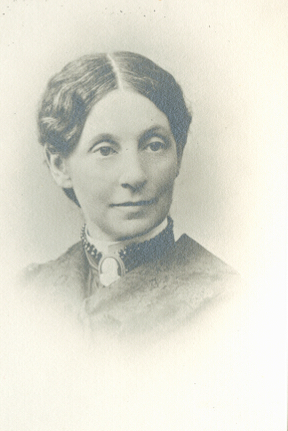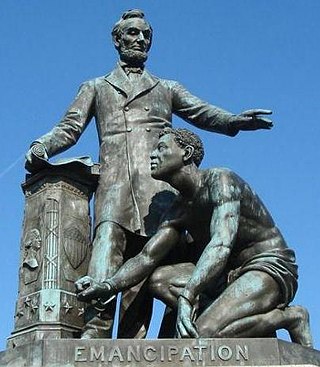
Frederick Douglass was an American social reformer, abolitionist, orator, writer, and statesman. He became the most important leader of the movement for African-American civil rights in the 19th century.

John Brown was a prominent leader in the American abolitionist movement in the decades preceding the Civil War. First reaching national prominence in the 1850s for his radical abolitionism and fighting in Bleeding Kansas, Brown was captured, tried, and executed by the Commonwealth of Virginia for a raid and incitement of a slave rebellion at Harpers Ferry in 1859.

William Lloyd Garrison was an American abolitionist, journalist, and social reformer. He is best known for his widely read anti-slavery newspaper The Liberator, which Garrison founded in 1831 and published in Boston until slavery in the United States was abolished by the Thirteenth Amendment in 1865.

Mary Ann Camberton Shadd Cary was an American-Canadian anti-slavery activist, journalist, publisher, teacher, and lawyer. She was the first black woman publisher in North America and the first woman publisher in Canada. She was also the second black woman to attend law school in the United States. Mary Shadd established the newspaper Provincial Freeman in 1853, which was published weekly in southern Ontario. it advocated equality, integration, and self-education for black people in Canada and the United States.
David Walker was an American abolitionist, writer, and anti-slavery activist. Though his father was enslaved, his mother was free; therefore, he was free as well. In 1829, while living in Boston, Massachusetts, with the assistance of the African Grand Lodge, he published An Appeal to the Colored Citizens of the World, a call for black unity and a fight against slavery.

Henry Highland Garnet was an American abolitionist, minister, educator, orator, and diplomat. Having escaped as a child from slavery in Maryland with his family, he grew up in New York City. He was educated at the African Free School and other institutions, and became an advocate of militant abolitionism. He became a minister and based his drive for abolitionism in religion.

The Liberator (1831–1865) was a weekly abolitionist newspaper, printed and published in Boston by William Lloyd Garrison and, through 1839, by Isaac Knapp. Religious rather than political, it appealed to the moral conscience of its readers, urging them to demand immediate freeing of the slaves ("immediatism"). It also promoted women's rights, an issue that split the American abolitionist movement. Despite its modest circulation of 3,000, it had prominent and influential readers, including all the abolitionist leaders, among them Frederick Douglass, Beriah Green, Arthur and Lewis Tappan, and Alfred Niger. It frequently printed or reprinted letters, reports, sermons, and news stories relating to American slavery, becoming a sort of community bulletin board for the new abolitionist movement that Garrison helped foster.

Narrative of the Life of Frederick Douglass, an American Slave is an 1845 memoir and treatise on abolition written by African-American orator and former slave Frederick Douglass during his time in Lynn, Massachusetts. It is the first of Douglass's three autobiographies, the others being My Bondage and My Freedom (1855) and Life and Times of Frederick Douglass.

Helen Pitts Douglass (1838–1903) was an American suffragist, known for being the second wife of Frederick Douglass. She also created the Frederick Douglass Memorial and Historical Association, which became the Frederick Douglass National Historic Site.

The Heroic Slave, a Heartwarming Narrative of the Adventures of Madison Washington, in Pursuit of Liberty is a short piece of fiction, or novella, written by abolitionist Frederick Douglass, at the time a fugitive slave based in Boston. When the Rochester Ladies' Anti Slavery Society asked Douglass for a short story to go in their collection, Autographs for Freedom, Douglass responded with The Heroic Slave. The novella, published in 1852 by John P. Jewett and Company, was Douglass's first and only published work of fiction.

Life and Times of Frederick Douglass is Frederick Douglass's third autobiography, published in 1881, revised in 1892. Because of the emancipation of American slaves during and following the American Civil War, Douglass gave more details about his life as a slave and his escape from slavery in this volume than he could in his two previous autobiographies. It is the only one of Douglass's autobiographies to discuss his life during and after the Civil War, including his encounters with American presidents such as Lincoln and Garfield, his account of the ill-fated "Freedman's Bank", and his service as the United States Marshall of the District of Columbia. Frederick Douglass shed light on what life was like as an enslaved person. Although it is the least studied and analyzed, Life and Times of Frederick Douglass allows readers to view his life as a whole.

The Emancipation Memorial, also known as the Freedman's Memorial or the Emancipation Group is a monument in Lincoln Park in the Capitol Hill neighborhood of Washington, D.C. It was sometimes referred to as the "Lincoln Memorial" before the more prominent national memorial was dedicated in 1922.

Anna Murray Douglass was an American abolitionist, member of the Underground Railroad, and the first wife of American social reformer and statesman Frederick Douglass, from 1838 to her death.
James Cropper (1773–1840) was an English businessman and philanthropist, known as an abolitionist who made a major contribution to the abolition of slavery throughout the British Empire in 1833.

Rosetta Douglass-Sprague was an American teacher and activist. She was a founding member of the National Association for Colored Women. Her mother was Anna Murray Douglass and her father was Frederick Douglass.

Frederick Augustus Washington Bailey Douglass Jr. was the second son of Frederick Douglass and his wife Anna Murray Douglass. Born in New Bedford, Massachusetts, he was an abolitionist, essayist, newspaper editor, and an official recruiter of African-American soldiers for the United States Union Army during the American Civil War.

Abolitionism in New Bedford, Massachusetts, began with the opposition to slavery voiced by Quakers during the late 1820s, followed by African Americans forming the antislavery group New Bedford Union Society in 1833, and an integrated group of abolitionists forming the New Bedford Anti-Slavery Society a year later. During the era New Bedford, Massachusetts, gained a reputation as a safe haven for fugitive slaves seeking freedom. Located on the East Coast of the United States, the town was becoming the "whaling capital of the world", where ships frequently returned to port, operated by crews of diverse backgrounds, languages, and ethnicity. This made it easy for fugitive slaves to "mix in" with crew members. The whaling and shipping industries were also uniquely open to people of color.
Nathan Johnson was an African-American abolitionist who sheltered fugitive slaves, most notably Frederick Douglass, and was a successful businessman in New Bedford, Massachusetts. He married Mary Durfee, nicknamed Polly, who was his business partner in their confectionery and catering businesses. In 1849, Nathan followed the Gold Rush to California. Polly died in 1871 and Nathan returned after her death and was a beneficiary of her estate.

A statue of Frederick Douglass sculpted by Sidney W. Edwards, sometimes called the Frederick Douglass Monument, was installed in Rochester, New York in 1899 after it was commissioned by the African-American activist John W. Thompson. According to Visualising Slavery: Art Across the African Diaspora, it was the first statue in the United States that memorialized a specific African-American person.

The Emancipation Memorial, also known as the Freedman's Memorial or the Emancipation Group was a monument in Park Square in Boston. Designed and sculpted by Thomas Ball and erected in 1879, its sister statue is located in Lincoln Park in the Capitol Hill neighborhood of Washington, D.C. The Boston statue was taken down by the City of Boston on December 29, 2020, following a unanimous vote from the Boston Art Commission on June 30 to remove the memorial.

















